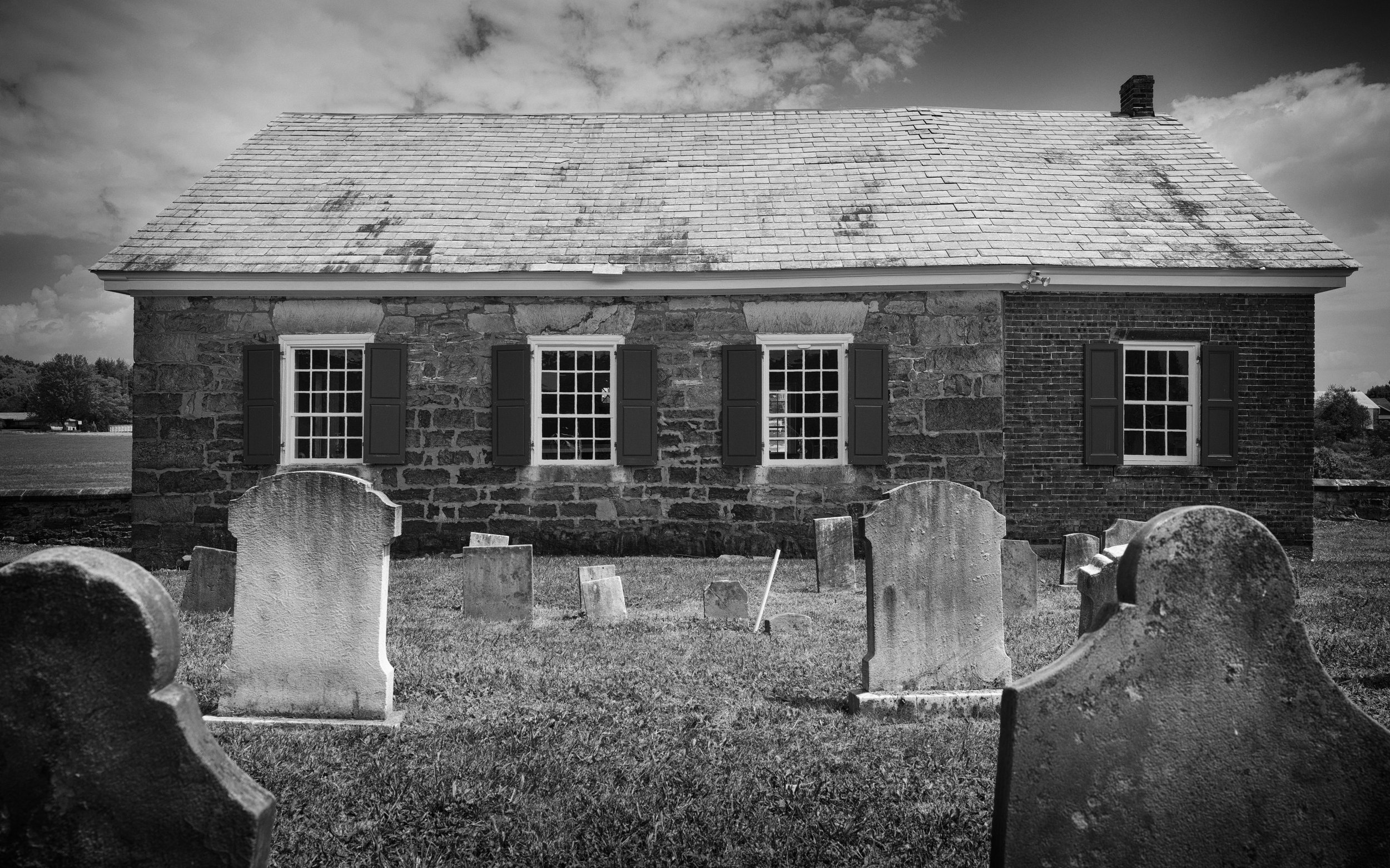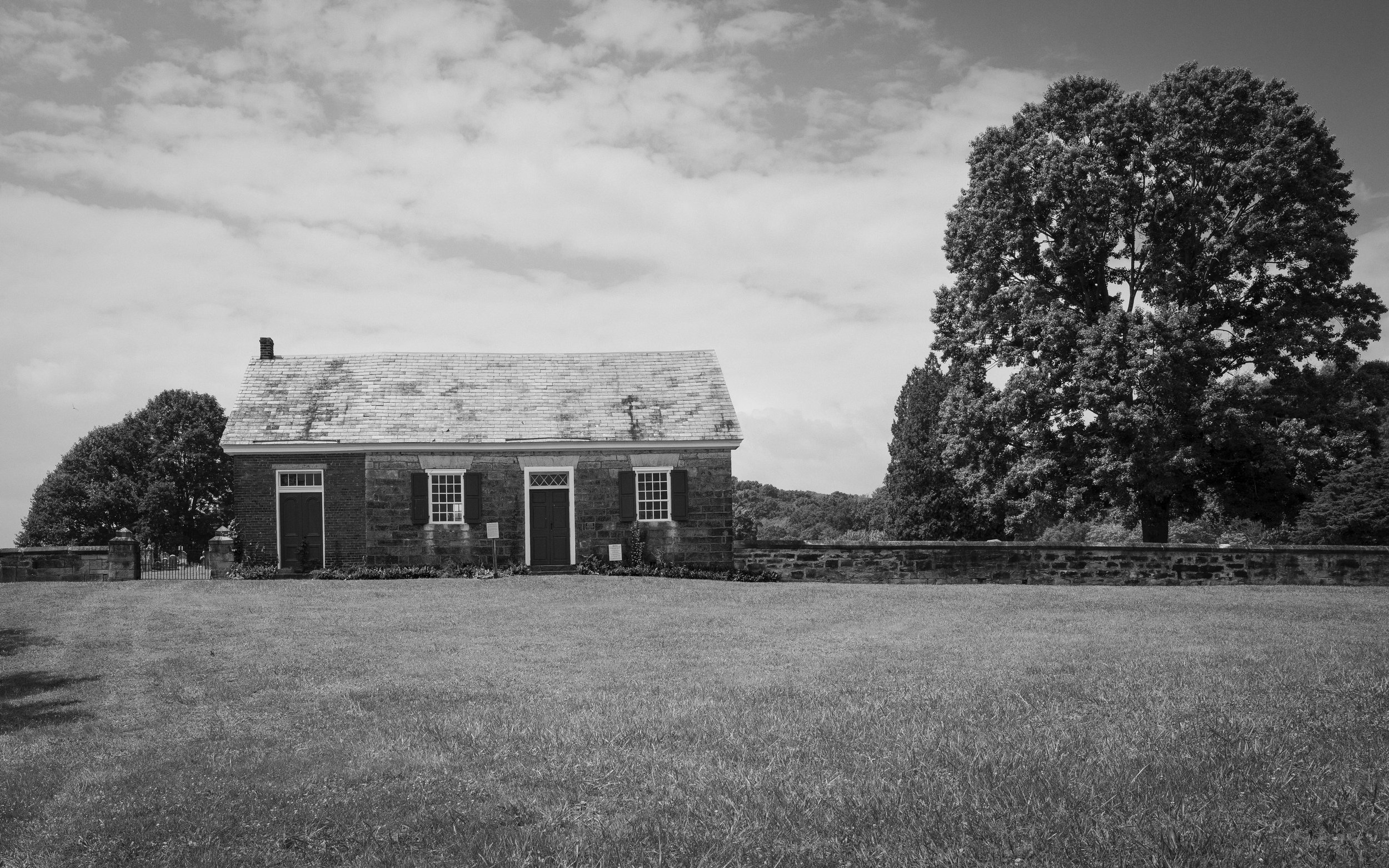Harmony
The Harmonist Cemetery in Harmony, PA. The solid stone doors, built by Mennonite craftsmen, are a notable feature.
At 6.00 a.m. one August morning, in the year 1811, the Scotsman John Melish and his companion, Dr Isaac Cleaver of Philadelphia, set out from Pittsburgh ‘on a couple of hacks, very sorry ones indeed,’ with the aim of visiting the Harmonist Society. The Harmonists were a religious community, founded seven years earlier, in 1804, by the Lutheran separatist George Rapp and his followers, a group of families who had made the long and perilous journey by land and sea from distant Wurttemberg, in present-day Germany, to seek the ‘land of Israel’ in the United States.
The two men, Melish and Cleaver, crossed the Allegany river by boat and made their way inland, in the increasingly oppressive heat of the morning, stopping to rest at Dixon’s tavern, where they found the landlord ‘completely drunk,’ before traveling on a few miles more to another tavern of a more salubrious sort, where they found ‘a sober, industrious family, busily employed in domestic manufactures.’
With a clear sense of priorities, and propriety, Melish pauses in his narration to give ‘an account of the rise and progress of the Harmonist Society,’ whose origins he dates to 1785, in ‘Wurtemberg, in Germany’ where, he declares, the ‘Lutheran religion was then predominant.’ In Melish’s telling, this ‘predominance’ was in fact a form of religious intolerance - worse,
The fundamental principles which Luther deduced from the doctrines of Jesus Christ and his apostles, were almost wholly destroyed; and in place of religion being made a principle to regenerate the mind, and regulate the life, it was converted into an engine of power, to keep the people in check to the civil government.’
Under these circumstances, Melish reports, George Rapp and his followers
…groaned for deliverance, and wished for a residence in some part of the world, where they might enjoy religious toleration, and be permitted to worship GOD according to the dictates of their consciences, unmolested by man.
The land of this deliverance was ‘discovered to the society,’ by ‘the providence of God,’ in America - it was if He had said, Melish records, ‘that is the country where you shall serve me, and where you shall confess my name.’
Rapp and a few others of his group were delegated, accordingly, ‘to go before … and seek out an eligible situation in that country.’
Arriving in Philadelphia in 1803, the small advance party struck west and, having ‘fixed on a situation … wrote to their friends.’ The following year, in 1804, ‘the whole society, consisting of 150 or 160 families, embarked in three vessels at Amsterdam.’ One ship docked in Baltimore, but the other two arrived in Philadelphia, where they were met by Rapp. Finally, after a ‘troublesome overland journey of 320 miles’ the first group of 40 families reached their promised land, and the following spring 50 more families arrived.
In February 1805, the society was organised into one body, with a constitution founded on Acts iv.32 - ‘the multitude of them that believed were of one heart, and of one soul: neither said any of them that aught of the things he possessed was his own, BUT THEY HAD ALL THINGS IN COMMON.’
Thus constituted, the community rapidly ‘laid out a town, and in commemoration of their unity of sentiment, and brotherly affection, they call it HARMONY; and from henceforth they continued to labour in brotherly association….’
Hard working, worshipful, the new settlers thrived: in the admiring language of the practical and pragmatic man that he evidently was, Melish devotes much of his subsequent account to enumerating and detailing the barns, log houses, mills of all sorts, shops, a brick meeting house, tanneries and warehouses, constructed by the Harmonists; the hundreds of acres that had been cleared, for corn, vines and meadows; the 600 bushels of grain that the society had sold in 1807, and the 3000 gallons of whiskey. Here is Melish, describing the progress made the following year, in 1808:
In 1808 they built a MEETING-HOUSE of brick, 70 feet by 55; a brick dwelling-house, and some other buildings, and stables for cattle; a frame barn, 80 feet long; a bridge 220 feet long over the Conaquenesing creek. A considerable quantity of ground was cleared, and they sold 2000 bushels of grain, and manufactured 1400 into whisky.
Only four short years after Melish’s visit, however, in 1815, the town and 6000 acres were sold by the society to Harmony’s ‘second founder,’ Abraham Ziegler, a Mennonite blacksmith, and it was the Mennonites who shaped the development of the town thereafter. The Harmonists moved to the Indiana Territory, where they founded New Harmony, before moving back to Pennsylvania in 1824 to found the town of Economy, now Ambridge, on the Ohio River, just 22 miles from their original home.
Meeting House and Cemetery
The Harmony Society, according to Wikipedia, ‘exerted a major influence on the economic development of Western Pennsylvania,’ and the Harmonist’s model of ‘placing the manufacturer beside the agriculturalist’ aroused the interest of contemporary policy makers, politicians, economists and social reformers.
One wonders what John Melish and his companion would have made of the Harmony Society’s subsequent history - its visible success, and its ultimate demise. For the Harmonists, free now to believe in the dictates of their own conscience and the teachings of their own religious leaders, believed among other things that the Second Coming of Jesus was nigh, and in this belief chose celibacy as a way of life. Nature being what it is, and the laws of biology being what they are, they ultimately died out.
It is tempting at this point in the narrative to follow Melish with some moralising of my own - what lessons might we draw, from the Harmonist’s experience - from their faith, their industry, their worthy commitment to brotherhood and the common good? And, conversely, what warnings might we derive from their closed system of beliefs, their millenarian and ultimately fatal faith?
But this would amount to a teleological view of history - history as fable or ideology, the turning of evidence and facts to serve a predetermined narrative.
Much more interesting, I think - and more Harmonious - to invite each of us to think about these complex, tough, and very human questions, in the light of our own consciences and our lived experience.
Still, I can’t help but wonder what the Harmonists, disembarking from their ships in their real yet imagined ‘land of Israel’ would make of today’s world, and today’s America. What would they think, say, of poverty and inequality in the self-styled ‘land of the brave’ or of Donald Trump (the Trumpian reference is no accident - as we drove through the county, Trump 2024 signs, appallingly, bloomed like poisonous weeds on many of the lawns).
We can’t speak for the Harmonists, of course, though there is the historical record - the buildings built, the harvests reaped, the products made and produce sold. The written word, and behind the words, the silent thoughts, the prayers and chatter and conversation, the faces and expressions - hopeful, bewildered, joyful, sad - of generations past. The voices lost, the efforts long since expended, the hopes realised and dashed.
You stand on this ground, and try imagining this place through Melish’s eyes, through the eyes of George Rapp and the Harmony Society, and you compose a few photographs, wishing the photographs had tongues, and could speak for themselves.
Quotations are from Harmony in 1811, excerpted from Travels in the United States of America, by John Melish. Historic Harmony Inc., 2003
Harmony, PA. 2023
These photographs are part of a collection of photographs scattered over time and place that I have called ‘Americana’ - images of a country that has been written about, photographed, studied and commented upon from many perspectives - think Robert Frank, Robert Adams, Walker Evans - yet remains (to the outsider at least) elusive: strangely familiar, yet often alien.
Postcards and Collages
I am delighted to be able to share, once again, some of Rob’s fabulous collages - I’m sure you will enjoy them as much as I do!
Rob writes:
Recently, a friend was clearing out things from her place and gave me a bag of postcards she longer longer wanted including many cards with black & white photos by Robert Doisneau. I decided to give myself a challenge and turn them into collages using images only from the postcards given to me. I think these are the best ones- hope you enjoy them. Many thanks to Francine!
Poem
On my 70th birthday
I saw you in the shadows, on the porch.
Changed, unchanged. You looked like me.
Cigar, smile, glass of whiskey.
Our solemn street was quiet, too -
hardly a stir among the leaves.
You might be still, but still I knew
you count the time and things to do.
Why not, I thought. Why wouldn’t you.
© Glen Fisher
Editor’s Applause, Frames Magazine
Buffalo, Cape West Coast, 2023
Editor’s Applause from Frames Magazine on 8 August for this photograph.
Glasgow Gallery of Photography
Dutch Reformed Church, Colesberg, South Africa, 2022
This photograph, of the Dutch Reformed Church in Colesberg, has been selected for the Light and Shadow Exhibition, showing at the Glasgow Gallery of Photography from 2 - 23 December. The image is one of a series on country churches in the Karoo region and in small provincial towns in South Africa.
Praxis Photo Arts Center
This photograph has been accepted by the Praxis Gallery & Photo Arts Center in Minneapolis for The Found Object exhibition this September.
Beach Buoy. Langebaan, South Africa, 2023

















